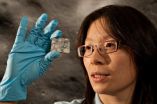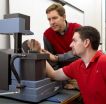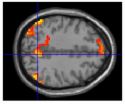(Press-News.org) The Moon, Earth's closest neighbor, has long been studied to help us better understand our own planet. Of particular interest is the lunar interior, which could hold clues to its ancient origins. In an attempt to extract information on the very deep interior of the Moon, a team of NASA-led researchers applied new technology to old data. Apollo seismic data was reanalyzed using modern methodologies and detected what many scientists have predicted: the Moon has a core.
According to the team's findings, published Jan. 6 in the online edition of Science, the Moon possesses an iron-rich core with a solid inner ball nearly 150 miles in radius, and a 55-mile thick outer fluid shell.
"The Moon's deepest interior, especially whether or not it has a core, has been a blind spot for seismologists," says Ed Garnero, a professor at the School of Earth and Space Exploration in ASU's College of Liberal Arts and Sciences. "The seismic data from the old Apollo missions were too noisy to image the Moon with any confidence. Other types of information have inferred the presence of a lunar core, but the details on its size and composition were not well constrained."
Sensitive seismographs scattered across Earth make studying our planet's interior possible. After earthquakes these instruments record waves that travel through the interior of the planet, which help to determine the structure and composition of Earth's layers. Just as geoscientists study earthquakes to learn about the structure of Earth, seismic waves of "moonquakes" (seismic events on the Moon) can be analyzed to probe the lunar interior.
When Garnero and his graduate student Peiying (Patty) Lin heard about research being done to hunt for the core of the Moon by lead author Renee Weber at NASA's Marshall Space Flight Center, they suggested that array processing might be an effective approach, a method where seismic recordings are added together in a special way and studied in concert. The multiple recordings processed together allow researchers to extract very faint signals. The depth of layers that reflect seismic energy can be identified, ultimately signifying the composition and state of matter at varying depths.
"Array processing methods can enhance faint, hard-to-detect seismic signals by adding seismograms together. If seismic wave energy goes down and bounces off of some deep interface at a particular depth, like the Moon's core-mantle boundary, then that signal "echo" should be present in all the recordings, even if below the background noise level. But when we add the signals together, that core reflection amplitude becomes visible, which lets us map the deep Moon," explains Lin, who is also one of the paper's authors.
The team found the deepest interior of the moon to have considerable structural similarities with the Earth. Their work suggests that the lunar core contains a small percentage of light elements such as sulfur, similar to light elements in Earth's core – sulfur, oxygen and others.
"There are a lot of exciting things happening with the Moon, like Professor Mark Robinson's LRO mission producing hi-res photos of amazing phenomena. However, just as with Earth, there is much we don't know about the lunar interior, and that information is key to deciphering the origin and evolution of the Moon, including the very early Earth," explains Garnero.
INFORMATION:
Caption: Patty Lin, a postdoctoral candidate in ASU's School of Earth and Space Exploration, holds Northwest Africa 5000, a lunar meteorite in the collection of the ASU Center for Meteorite Studies. Lin and her advisor Professor Ed Garnero use seismology to study inaccessible regions of Earth's interior, a technique they are now applying on the Moon to learn more about Earth's natural satellite. Photo credit: Tom Story/ASU.
ASU SOURCES:
Peiying (Patty) Lin, patty.lin@asu.edu
480.965.7680
Ed Garnero, garnero@asu.edu
480.965.7653
MEDIA CONTACT:
Nicole (Staab) Cassis, nstaab@asu.edu
602.710.7169
Arizona State University (www.asu.edu)¬¬
School of Earth and Space Exploration (http://sese.asu.edu)
Tempe, Arizona USA
The hunt for the lunar core
Deep interior of moon resembles Earth's core
2011-01-07
ELSE PRESS RELEASES FROM THIS DATE:
Standing tall is key for success in 2011
2011-01-07
Show enthusiasm, ask questions and bring copies of a resume. These are just a handful of the most common interview tips for job seekers, but a person's posture may also be a deciding factor for whether they land a coveted position – even when the person on the other side of the desk is in a more powerful role.
According to new research from the Kellogg School of Management at Northwestern University, posture plays an important role in determining whether people act as though they are really in charge. The research finds that "posture expansiveness," or positioning oneself ...
The 'mad' Egyptian scholar who proved Aristotle wrong
2011-01-07
Ibn al-Haytham's 11th-century Book of Optics, which was published exactly 1000 years ago, is often cited alongside Newton's Principia as one of the most influential books in physics. Yet very little is known about the writer, considered by many to be the father of modern optics.
January's Physics World features a fanciful re-imagining of the 10-year period in the life of the medieval Muslim polymath, written by Los Angeles-based science writer Jennifer Ouellette.
The feature covers the time when al-Haytham -- banished from society and deprived of books -- came up with ...
Young people say sex, paychecks come in second to self-esteem
2011-01-07
COLUMBUS, Ohio – Young people may crave boosts to their self-esteem a little too much, new research suggests.
Researchers found that college students valued boosts to their self-esteem more than any other pleasant activity they were asked about, including sex, favorite foods, drinking alcohol, seeing a best friend or receiving a paycheck.
"It is somewhat surprising how this desire to feel worthy and valuable trumps almost any other pleasant activity you can imagine," said Brad Bushman, lead author of the research and professor of communication and psychology at The ...
Iowa State, Ames Lab researcher developing bio-based polymers that heal cracks
2011-01-07
AMES, Iowa – Michael Kessler has worked with polymers that repair themselves when they crack. And he's worked with polymers made from vegetable oils. Now he's working to combine the two technologies.
Kessler, an Iowa State University associate professor of materials science and engineering and an associate of the U.S. Department of Energy's Ames Laboratory, is researching and developing biorenewable polymers capable of healing themselves as they degrade and crack.
"If successful, the results of this research will provide biorenewable alternatives to petroleum-based ...
Extracting cellular 'engines' may aid in understanding mitochondrial diseases
2011-01-07
VIDEO:
Extracting mitochondria from a human cell (larger object on bottom right) is a tricky process. NIST researchers recently developed techniques that can surgically remove these tiny cellular engines, potentially enabling...
Click here for more information.
Medical researchers who crave a means of exploring the genetic culprits behind a host of neuromuscular disorders may have just had their wish granted by a team working at the National Institute of Standards and Technology ...
Faulty 'off-switch' stops children with ADHD from concentrating
2011-01-07
Brain scans of children with attention-deficit/hyperactivity disorder (ADHD) have shown for the first time why people affected by the condition sometimes have difficulty in concentrating. The study, by experts at The University of Nottingham, may explain why parents often say that their child can maintain concentration when they are doing something that interests them, but struggles with boring tasks.
Using a 'Whac-a-Mole' style game, researchers from the Motivation, Inhibition and Development in ADHD Study (MIDAS) group found evidence that children with ADHD require ...
NIST telescope calibration may help explain mystery of universe's expansion
2011-01-07
Is the expansion of the universe accelerating for some unknown reason? This is one of the mysteries plaguing astrophysics, and somewhere in distant galaxies are yet-unseen supernovae that may hold the key. Now, thanks to a telescope calibrated by scientists from the National Institute of Standards and Technology (NIST), Harvard University and the University of Hawaii, astrophysicists can be more certain of one day obtaining an accurate answer.
The NIST scientists traveled to the summit of Haleakala volcano in Hawaii to fine-tune the operation of billions of light-collecting ...
IPv6 guide provides path to secure deployment of next-generation Internet protocol
2011-01-07
As the day draws nearer for the world to run out of the unique addresses that allow us to use the Internet—now predicted to happen by the end of 2012—researchers at the National Institute of Standards and Technology (NIST) have issued a guide for managers, network engineers, transition teams and others to help them deploy the next generation Internet Protocol (IPv6) securely.
Guidelines for the Secure Deployment of IPv6 (NIST Special Publication 800-119), describes the features of IPv6 and the possible related security impacts, provides a comprehensive survey of mechanisms ...
2 publications recommend organization-wide IT security risk management
2011-01-07
Two new draft publications from the National Institute of Standards and Technology (NIST) provide the groundwork for a three-tiered risk-management approach that encompasses computer security risk planning from the highest levels of management to the level of individual systems. The draft documents have been released for public comment.
Both publications are a part of NIST's risk management guidelines, which have been developed in support of the Federal Information Security Management Act (FISMA), and adopted government wide to improve the security of government systems ...
Princeton scientists construct synthetic proteins that sustain life
2011-01-07
In a groundbreaking achievement that could help scientists "build" new biological systems, Princeton University scientists have constructed for the first time artificial proteins that enable the growth of living cells.
The team of researchers created genetic sequences never before seen in nature, and the scientists showed that they can produce substances that sustain life in cells almost as readily as proteins produced by nature's own toolkit.
"What we have here are molecular machines that function quite well within a living organism even though they were designed ...
LAST 30 PRESS RELEASES:
Do our body clocks influence our risk of dementia?
Anthropologists offer new evidence of bipedalism in long-debated fossil discovery
Safer receipt paper from wood
Dosage-sensitive genes suggest no whole-genome duplications in ancestral angiosperm
First ancient human herpesvirus genomes document their deep history with humans
Why Some Bacteria Survive Antibiotics and How to Stop Them - New study reveals that bacteria can survive antibiotic treatment through two fundamentally different “shutdown modes”
UCLA study links scar healing to dangerous placenta condition
CHANGE-seq-BE finds off-target changes in the genome from base editors
The Journal of Nuclear Medicine Ahead-of-Print Tip Sheet: January 2, 2026
Delayed or absent first dose of measles, mumps, and rubella vaccination
Trends in US preterm birth rates by household income and race and ethnicity
Study identifies potential biomarker linked to progression and brain inflammation in multiple sclerosis
Many mothers in Norway do not show up for postnatal check-ups
Researchers want to find out why quick clay is so unstable
Superradiant spins show teamwork at the quantum scale
Cleveland Clinic Research links tumor bacteria to immunotherapy resistance in head and neck cancer
First Editorial of 2026: Resisting AI slop
Joint ground- and space-based observations reveal Saturn-mass rogue planet
Inheritable genetic variant offers protection against blood cancer risk and progression
Pigs settled Pacific islands alongside early human voyagers
A Coral reef’s daily pulse reshapes microbes in surrounding waters
EAST Tokamak experiments exceed plasma density limit, offering new approach to fusion ignition
Groundbreaking discovery reveals Africa’s oldest cremation pyre and complex ritual practices
First breathing ‘lung-on-chip’ developed using genetically identical cells
How people moved pigs across the Pacific
Interaction of climate change and human activity and its impact on plant diversity in Qinghai-Tibet plateau
From addressing uncertainty to national strategy: an interpretation of Professor Lim Siong Guan’s views
Clinical trials on AI language model use in digestive healthcare
Scientists improve robotic visual–inertial trajectory localization accuracy using cross-modal interaction and selection techniques
Correlation between cancer cachexia and immune-related adverse events in HCC
[Press-News.org] The hunt for the lunar coreDeep interior of moon resembles Earth's core



